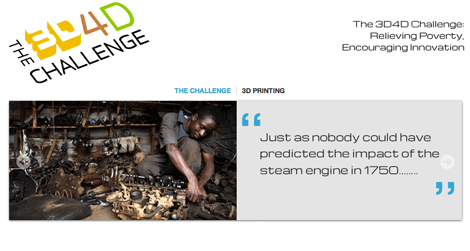
A few weeks back we attended the London workshop of the 3D4D Challenge, where we huddled down with our ideas of how the materials and build methods of 3D printing could help the developing world.
The idea is to apply the ability to design in one place, and construct in another, to reduce costs and poverty in communities that do not have the funds or facilities to construct, say, parts for a water pump or a prosthetic limb, while providing possibilities for local employment.
We piggy-backed its interview with Dr Phil Reeves, managing director of Econolyst, which advises companies around the world on the use of 3D Printing and Additive Manufacturing, to get some inside inspiration on what makes a winning idea, and how these workshops can make a difference to people’s lives:
What interests you in the discussion and ideas coming up at the workshops?
As a company we have spent years taking with manufacturers and consumers within the west about how 3D Printing can be used to improve the retail experience or provide personalised consumer products. “The 3D4D Challenge opens up a whole new debate about now 3D Printing can support people’s needs rather than wants. I love the ideas coming out of the workshops, as they are all focused on improving peoples quality of life, rather than personal vanity or consumerism. The ideas are driven by genuine need within societies and economies we in the west have very little understanding of. However, with 3DP we are putting the tools into the hands of the people who see the problems first hand – that excites me!”
What’s the benefit for Econolyst and how can you help?
“For Econolyst we are benefiting by gaining a much wider appreciation of now 3DP can be used, it is expanding our knowledge and experience and as a consultancy firm that is paramount. In terms of what we are giving back, hopefully it is years on experience in how to use these technologies for economic and sustainable advantage.”
What wider interest are you seeing around the world in these innovations?
“3DP is finding its way into so many aspects of our lives, from healthcare products and devices such as hip implants, dental aligners and hearing aids, through to consumer goods such as lamp shades, toys, furniture and IPhone covers. The technology is also finding its way into aerospace and automotive applications as well as defence and power generation. We are now able to produce production components using 3DP in metals, polymers and ceramics. In the future we also expect to see 3DP of human tissue and cells used in regenerative medicine.”
What maintains your enthusiasm for these developments?
“We live in a digitally connected world, where the internet and data have revolutionised many industries from music, films and TV, through to hotel and travel booking. 3DP enables this internet revolution to extend into the manufacture of tangible products. Using social media and home based 3DP it also allows anyone with a great product to become both a factory and a retail outlet. Democratising manufacturing to all.”
What makes a winning application?
“For the 3D4D Challenge a winning application will be one that truly exploits the flexibility and digital connectivity of 3D Printing, but at the same time brings a real social benefit to people living in the developing world. That might be agricultural development, healthcare, education or access to clean drinking water. We would love to see ideas that address these import issue using 3DP, maybe integrated with mobile phone technology or the internet. In short it is all about improving lives using technology.”
What’s going to happen at the Bucharest workshop?
“In Bucharest we will be meeting with a group of engineering students, graduates, innovators and academics. Like over 3D4D events in Kenya, South Africa, India, London and America we will be explaining the concept and rules of the challenge. But, I am also going to be giving a couple of short seminars on 3D Printing. The first will cover the drivers to technology adoption and why it is progressively being used by companies and innovators. In the second session we are going to be getting down to the technical stuff and discussing the capabilities and constraints of different 3DP processes. The idea is to give the guys in Bucharest as much knowledge as possible to come up with some great ideas.”
It’s less of a pipe-dream than you’d imagine, with a £100,000 development prize going to the winner of this international competition, as well as the good work it does in bringing investors and designers together – with the final workshop taking place in Bucharest on 22 June, and final competition entries to be entered before the 31 July deadline.






